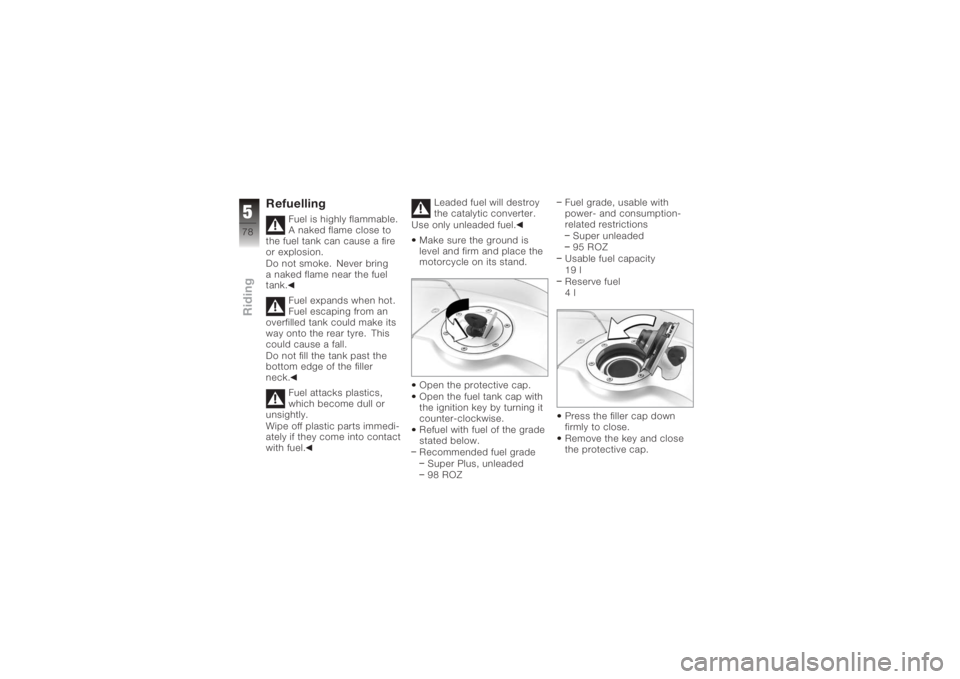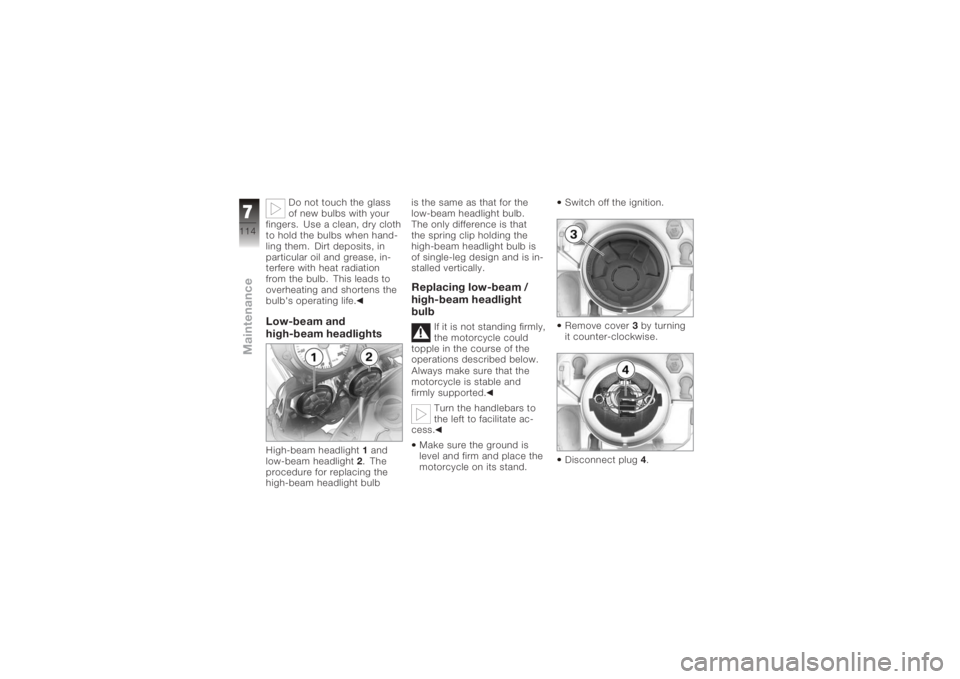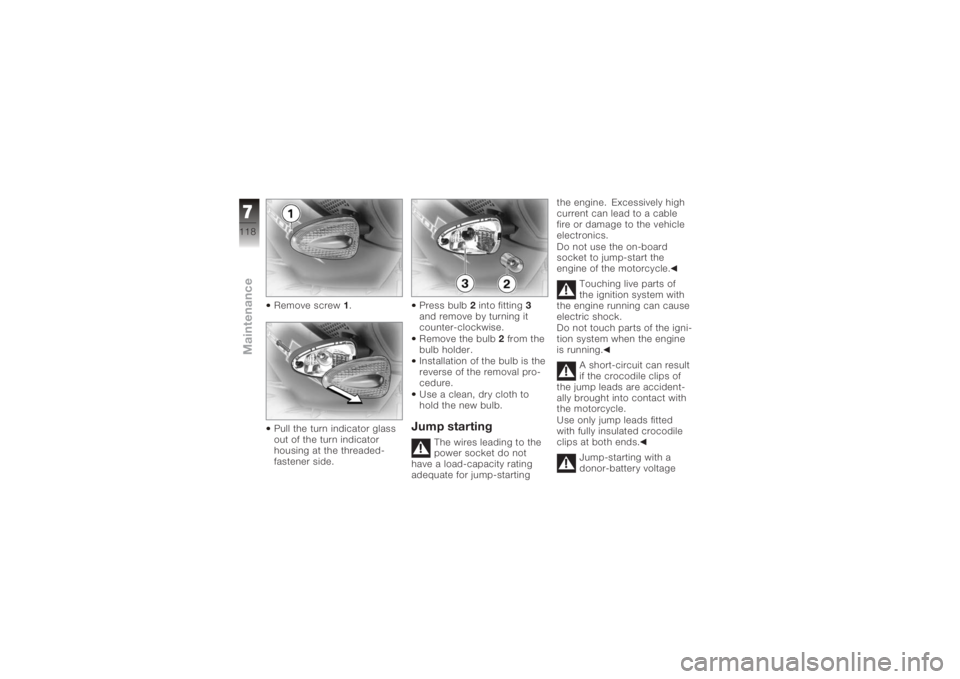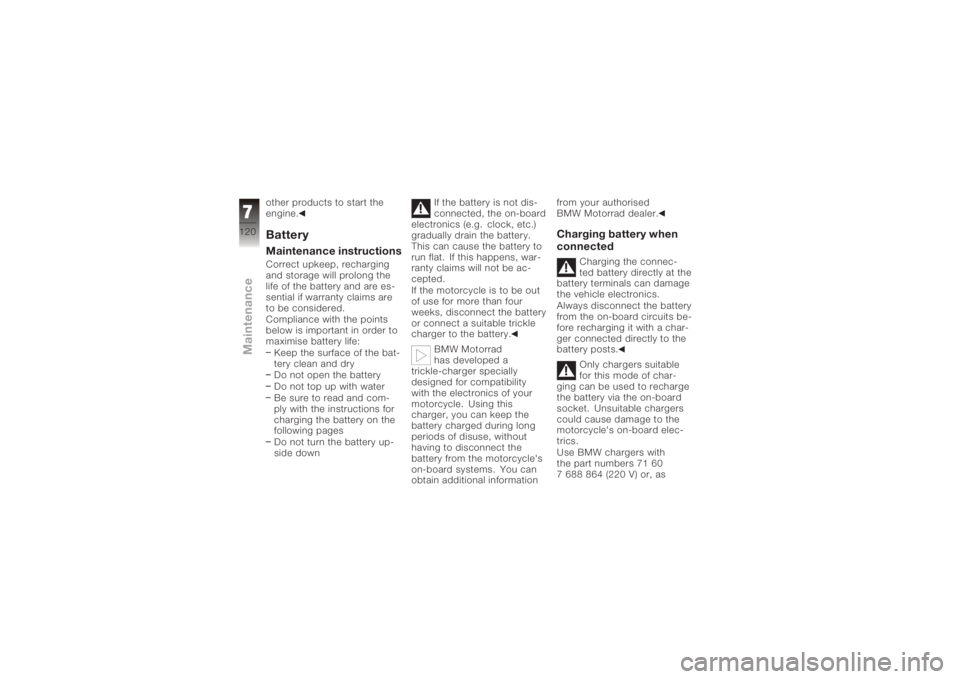Page 54 of 165
Turn the key counter-
clockwise in the seat
lock.
Press the seat down at the
same time.Lift the rear of the seat.
The seat can be dam-
aged at the edges if it is
placed on a rough surface.
Lay the seat upholstered side
down on a smooth, clean sur-
face, such as the fuel tank.
Release the key and pull the
seat back out of its holder.
Installing the seatMake sure the ground is
level and firm and place the
motorcycle on its stand. If too much pressure is
applied in the forward
direction, there is a danger
that the motorcycle will be
pushed off its stand.
Always make sure that the
motorcycle is stable and
firmly supported.
Push the seat forward into
holders 1.
452zOperation
Page 80 of 165

Refuelling
Fuel is highly flammable.
A naked flame close to
the fuel tank can cause a fire
or explosion.
Do not smoke. Never bring
a naked flame near the fuel
tank.
Fuel expands when hot.
Fuel escaping from an
overfilled tank could make its
way onto the rear tyre. This
could cause a fall.
Do not fill the tank past the
bottom edge of the filler
neck.
Fuel attacks plastics,
which become dull or
unsightly.
Wipe off plastic parts immedi-
ately if they come into contact
with fuel. Leaded fuel will destroy
the catalytic converter.
Use only unleaded fuel.
Make sure the ground is
level and firm and place the
motorcycle on its stand.
Open the protective cap.
Open the fuel tank cap with
the ignition key by turning it
counter-clockwise.
Refuel with fuel of the grade
stated below.
Recommended fuel gradeSuper Plus, unleaded
98 ROZ Fuel grade, usable with
power- and consumption-
related restrictions
Super unleaded
95 ROZ
Usable fuel capacity
19 l
Reserve fuel
4l
Press the filler cap down
firmly to close.
Remove the key and close
the protective cap.
578zRiding
Page 116 of 165

Do not touch the glass
of new bulbs with your
fingers. Use a clean, dry cloth
to hold the bulbs when hand-
ling them. Dirt deposits, in
particular oil and grease, in-
terfere with heat radiation
from the bulb. This leads to
overheating and shortens the
bulb's operating life.
Low-beam and
high-beam headlightsHigh-beam headlight 1and
low-beam headlight 2. The
procedure for replacing the
high-beam headlight bulb is the same as that for the
low-beam headlight bulb.
The only difference is that
the spring clip holding the
high-beam headlight bulb is
of single-leg design and is in-
stalled vertically.
Replacing low-beam /
high-beam headlight
bulb
If it is not standing firmly,
the motorcycle could
topple in the course of the
operations described below.
Always make sure that the
motorcycle is stable and
firmly supported.
Turn the handlebars to
the left to facilitate ac-
cess.
Make sure the ground is
level and firm and place the
motorcycle on its stand. Switch off the ignition.
Remove cover
3by turning
it counter-clockwise.
Disconnect plug 4.
7114zMaintenance
Page 118 of 165
Pull the bulb housing for-
ward to remove it and tilt it
slightly down.
Remove bulb holder2from
the headlight housing by
turning it counter-clockwise. Remove bulb
3from the
bulb holder.
Installation of the bulb is the
reverse of the removal pro-
cedure.
Use a clean, dry cloth to
hold the new bulb. The headlight cable
could catch in the
steering if it is not routed
correctly.
Use the appropriate retaining
clips to secure electric wires
at the back of the headlight.
Push the bulb housing into
mounts 4on the frame and
install the securing screws.
Replacing the brake light
and rear light bulbs
If it is not standing firmly,
the motorcycle could
7116zMaintenance
Page 119 of 165
topple in the course of the
operations described below.
Always make sure that the
motorcycle is stable and
firmly supported.Make sure the ground is
level and firm and place the
motorcycle on its stand.
Removing the seat ( 51)
Switch off the ignition.
Remove screw 1. Pull the bulb housing to the
rear until it is clear of hold-
ers
2.
Turn bulb holder 3counter-
clockwise to remove it from
the bulb housing. Press the bulb into
its socket and turn it
counter-clockwise to
remove.
Installation of the brake light
and rear light bulbs is the
reverse of the removal pro-
cedure.
Use a clean, dry cloth to
hold the new bulb.
Replacing turn indicator
bulbs, front/rear
If it is not standing firmly,
the motorcycle could
topple in the course of the
operations described below.
Always make sure that the
motorcycle is stable and
firmly supported.
Make sure the ground is
level and firm and place the
motorcycle on its stand.
Switch off the ignition.
7117zMaintenance
Page 120 of 165

Remove screw1.
Pull the turn indicator glass
out of the turn indicator
housing at the threaded-
fastener side. Press bulb
2into fitting 3
and remove by turning it
counter-clockwise.
Remove the bulb 2 from the
bulb holder.
Installation of the bulb is the
reverse of the removal pro-
cedure.
Use a clean, dry cloth to
hold the new bulb.
Jump starting
The wires leading to the
power socket do not
have a load-capacity rating
adequate for jump-starting the engine. Excessively high
current can lead to a cable
fire or damage to the vehicle
electronics.
Do not use the on-board
socket to jump-start the
engine of the motorcycle.
Touching live parts of
the ignition system with
the engine running can cause
electric shock.
Do not touch parts of the igni-
tion system when the engine
is running.
A short-circuit can result
if the crocodile clips of
the jump leads are accident-
ally brought into contact with
the motorcycle.
Use only jump leads fitted
with fully insulated crocodile
clips at both ends.
Jump-starting with a
donor-battery voltage
7118zMaintenance
Page 122 of 165

other products to start the
engine.BatteryMaintenance instructionsCorrect upkeep, recharging
and storage will prolong the
life of the battery and are es-
sential if warranty claims are
to be considered.
Compliance with the points
below is important in order to
maximise battery life:Keep the surface of the bat-
tery clean and dry
Do not open the battery
Do not top up with water
Be sure to read and com-
ply with the instructions for
charging the battery on the
following pages
Do not turn the battery up-
side down If the battery is not dis-
connected, the on-board
electronics (e.g. clock, etc.)
gradually drain the battery.
This can cause the battery to
run flat. If this happens, war-
ranty claims will not be ac-
cepted.
If the motorcycle is to be out
of use for more than four
weeks, disconnect the battery
or connect a suitable trickle
charger to the battery.
BMW Motorrad
has developed a
trickle-charger specially
designed for compatibility
with the electronics of your
motorcycle. Using this
charger, you can keep the
battery charged during long
periods of disuse, without
having to disconnect the
battery from the motorcycle's
on-board systems. You can
obtain additional information from your authorised
BMW Motorrad dealer.
Charging battery when
connected
Charging the connec-
ted battery directly at the
battery terminals can damage
the vehicle electronics.
Always disconnect the battery
from the on-board circuits be-
fore recharging it with a char-
ger connected directly to the
battery posts.
Only chargers suitable
for this mode of char-
ging can be used to recharge
the battery via the on-board
socket. Unsuitable chargers
could cause damage to the
motorcycle's on-board elec-
trics.
Use BMW chargers with
the part numbers 71 60
7 688 864 (220 V) or, as
7120zMaintenance
Page 126 of 165
Install screws1.
Switch on the ignition.
Fully open the throttle once
or twice.
The engine management
system registers the
throttle-valve position.
Setting the clock ( 46)
7124zMaintenance